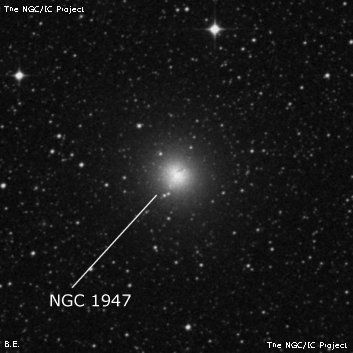
James Dunlop discovered NGC 1947 on 5 Nov 1826 with his 9" reflector although the observation was not included in his 1828 catalogue. Glen Cozens found the observation by examining Dunlop's handwritten notes. John Herschel independently discovered this galaxy on 30 Nov 1834 and described h2855 as "pB, L, R, glbM; 2.5' diameter, a star 9th mag N.p.". There is nothing at his position but exactly 1 degree north is ESO 85-87, an unusual elliptical with a minor-axis dust lane, and mag 9.7 HD 36355 (matching his description) is 4.4' NNW.
Due to his erroneous position, Joseph Turner was unable to find it when he searched for it on 12 Dec 1878 with the 48-inch Melbourne Telescope. Interestingly, Pietro Baracchi was unsucessful in finding NGC 1947 on two attempts with the Melbourne telescope, but reported finding a new nebula nearby (perhaps S-L 556) on 3 Jan 1886 that was confirmed the next night (no sketch to confirm). Robert Innes and Willem van den Bos observed it visually in 1926 with the 26-inch refractor at the Union Observatory and assumed the galaxy was a globular cluster and compared it to 47 Tucanae! Innes wrote, "very condensed globular, bM, 2' diam, a miniature of [47 Tuc]."
Eric Lindsay, in "Some NGC objects in the Large Magellanic Cloud" (1964IrAJ....6..286L), notes "The Decl. [recorded by Herschel] seems to be in error and the object is the well-known galaxy 1? N." In a paper on LMC clusters, Kontizas et al misidentifies KMH90-878 as NGC 1947 because of the dec error, though there doesn't appear to be a cluster on the DSS at the Kontizas position.
400/500mm - 18" (4/6/16 - Coonabarabran, 236x): fairly bright and large, slightly elongated, ~2.5'x2.0', well concentrated with a bright core that gradually increased to the center. A mag 9.7 star (HD 36355) lies 4.2' NNW. The LMC cluster NGC 1942 lies 17' SW and S-L 509 is 21' NE.
S-L 509 appeared fairly faint, fairly large, irregular glow, ~1.2' diameter, mottled. A mag 14.5 star is resolved at the SW edge of the glow and a mag 15.5 star is at the north edge.
600/800mm - 24" (4/4/08 - Magellan Observatory, Australia): very bright, large, round, contains a large, very bright core surrounded by a fainter halo with a total diameter of ~3'. Within the brighter 2' core is a sharply concentrated brighter nucleus. This is an impressive S0 or E-galaxy at 200x due to the high surface brightness core and several brightness levels. Situated in the northern outskirts of the LMC with S-L 509, a faint LMC cluster, 21' NE. On images, the minor axis of this elliptical is bisected by a dust lane, though this feature wasn't noticed.
Notes by Steve Gottlieb